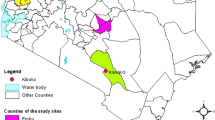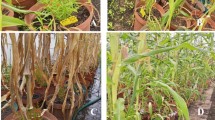Abstract
Once a resistant cultivar is developed, the hope is that the resistance which has been selected is durable. One way of making sure that the resistance obtained lasts long is the development of multiple resistance.
The International Institute of Tropical Agriculture (IITA), located in Ibadan, Nigeria, developed a maize population (TZBR) resistant to the stem-borer, Sesamia calamistis. The International Centre of Insect Physiology and Ecology (ICIPE), Nairobi, Kenya crossed this population with some of their lines resistant to Chilo partellus. The resultant crosses and lines derived from them were screened under natural infestation for multiple resistance to C. partellus and Eldana saccharina. Since the population had previously been screened for resistance to S. calamistis, lines identified in this study to have resistances to either C. partellus or E. saccharina or both, will be assumed to have maintained their resistance to S. calamistis unless proved otherwise.
Therefore, new sources of multiple resistance to stem-borers particularly S. calamistis, C. partellus and E. saccharina have been identified. Crosses between them would certainly offer a wide scope in the multiple resistance approach towards pest management.
Résumé
Des que un cultivar résistant se développe, on peut espérer que la résistance qui a été développe durera. Un des moyens de s’assurer que la résistance obtenue durera longtemps est le développement des résistances multiples.
L’Institut International d’Agriculture Tropicale (IITA) situé à Ibadan, Nigéria a développé une population de maïs qui résiste aux rongeurs de tige, Sesamia Calamistis. Le Centre International de Physiologie et d’Ecologie des Insectes, Nairobi, Kenya, a croisé cette population avec quelques unes de leurs lignées, resistant au Chilo partellus. Les croisements et les lingées resultants ont été examinés dans des conditoins d’infestation naturelle afin de voir s’il y a avait résistance multiple au C. partellus et Eldana saccharina. Etant donné que la population avait été examinée préalablement quant à sa résistance au S. calamistis, les lingées identifiées dans cette étude comme ayant une résistance soit au C. partellus ou au E. saccharina, ou aux deux, seront condidérées comme ayant maintenu leur résistance au S. calamistis sauf preuve contraire.
Par conséquent, de nouvelles sources de résistances mujltiples aux rongeurs de tiges en particulier S. calamistis, C. partellus et E. saccharina ont été identifiées. Leur croisement pourrait certainement offrir de grandes possibilités à l’approache des résistances multiples dans le controle des insectes.
Similar content being viewed by others
References
Dabrowski Z. T., Omolo E. O. and Nyangiri E. O. (1980) Resistance of maize to stem-borers. ICIPE 8th Annual Report.
Eberhart S. A., Harrison M. N. and Ogada F. (1967) A comprehensive breeding system. Der Zutcher 37, 169–174.
Omolo E. O. (1983) Screening of local and exotic maize lines for stem-borer resistance with special reference to Chilo partellus. Insect Sci. Applic. 4, 105–108.
Author information
Authors and Affiliations
Rights and permissions
About this article
Cite this article
Omolo, E.O., Seshu Reddy, K.V. Screening Maize Genotypes for Multiple Resistance to Stem-Borers. Int J Trop Insect Sci 6, 405–408 (1985). https://doi.org/10.1017/S1742758400004707
Received:
Published:
Issue Date:
DOI: https://doi.org/10.1017/S1742758400004707
Key Words
- Maize genotype
- Chilo partellus
- Eldana saccharina
- Sesamia calamistis
- multiple resistance
- durable resistance




